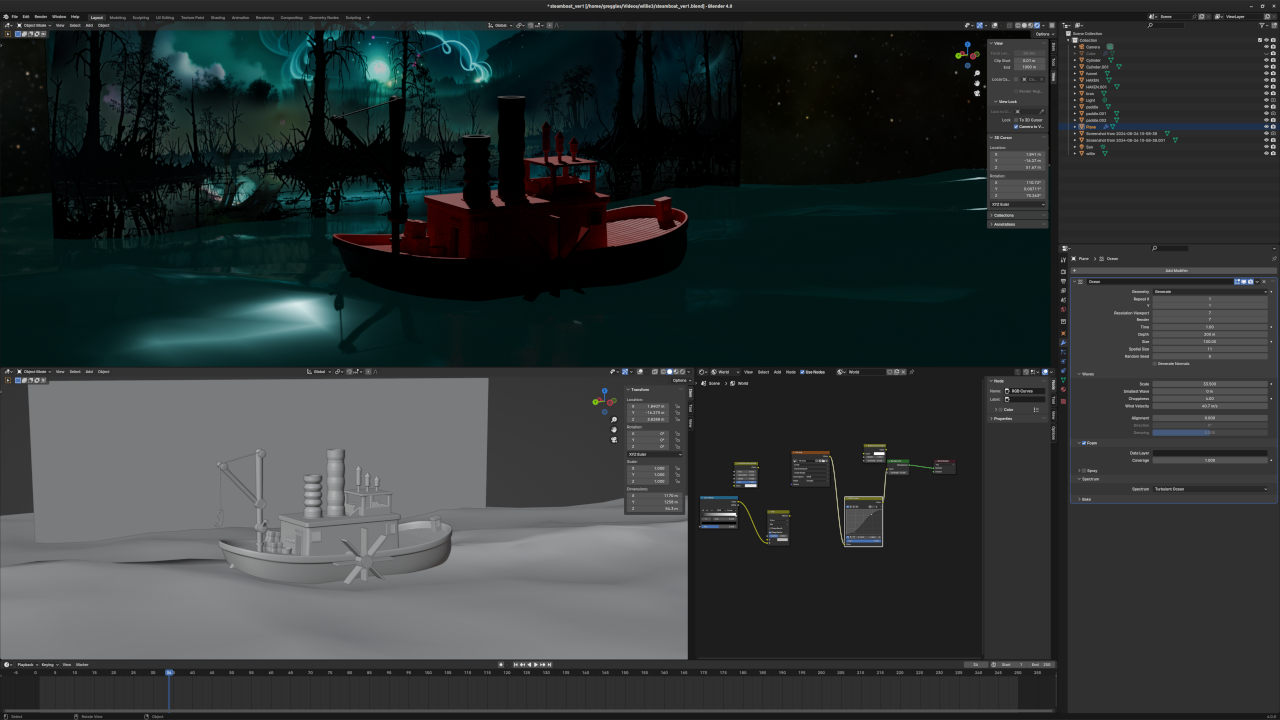The Melancholy adventures of Steamboat Willie: A Retrospective on the Project
Introduction
New and unique creative works often struggle to gain traction, while parodies or familiar characters tend to engage audiences more easily. This observation inspired the decision to update and colorize Steamboat Willie, a cartoon that had just entered the public domain. The project became a blend of nostalgia, experimentation, and irony, offering an opportunity to explore creative editing and graphics techniques.
This blog post provides a behind-the-scenes look at the project’s creation, from its conceptualization to its execution, and reflects on the lessons learned along the way.
Concept and Motivation
Using Steamboat Willie as the foundation was a strategic choice. The cartoon’s entry into the public domain allowed for creative freedom, while Walt Disney’s controversial legacy and the Disney Corporation’s history of intellectual property disputes added layers of commentary and parody. The project aimed to reimagine the classic cartoon with modern techniques, blending humor and deeper thematic elements.
Production Process
The production of Steamboat Willie was a labor-intensive process that involved several stages:
Initial (failed) Attempts:
Early versions of the project involved straightforward edits of the original cartoon. However, this approach proved time-consuming and unsustainable. To streamline the process, the project was divided into smaller, episodic segments, which could be released incrementally on social media and later stitched together.Rotoscoping and Colorization:
Rotoscoping—tracing each character frame by frame—and colorization formed the bulk of the work. Retaining the original character lines was essential to preserve the charm of the classic animation.
Compositing and Backgrounds:
New backgrounds were created or modified to fit the 16:9 aspect ratio, as the original 5:4 frames were too small. Some scenes required “outpainting” to fill in extended areas. Stock footage from a recent trip to Alaska was used extensively to create these backgrounds.AI Integration:
The underwater sequences featuring Black Pete utilized AI-generated visuals. These scenes were intentionally surreal and artificial, serving as a meta-commentary on the idea of a “fake” world.Color Correction and Consistency:
To unify the disparate visual elements, extreme color grading across the entire project was used to ensure a consistent look and feel despite the varied sources of the footage.
- Sound Design:
Sound effects included squeaky toys, radio static, and a parakeet. Whale noises were used for the mermaid, and a boat horn replaced the cow’s original sound. The music was original, created using an MIDI keyboard and LMMS music studio.

Themes and Narrative
At its heart, the video was about life, loss, and acceptance. The steamboat, named Charon (after the ferryman of the dead in Greek mythology), symbolized life’s journey. The river it traveled represented the passage of time, leading the characters—and, by extension, the audience—toward the inevitable end.
Throughout the episodes, the characters grew increasingly detached from one another, reflecting the inevitability of separation and mortality. The emotional arc of the story was intended to evoke a sense of melancholy and introspection, contrasting sharply with the lighthearted expectations of the original cartoon.
Challenges and Reflections
- Final Shots: The concluding scenes proved particularly challenging. Initially, they lacked an engauging story and required extensive reworking, eventually being condensed for the final cut.
Sustainability: The sheer volume of labor involved in producing each episode made it clear that creating content of this scale solo was unsustainable.
Audience Reception: While the project achieved moderate success (with an estimated 3,000 views across platforms - not bad, not viral), many viewers failed to pick up on the deeper themes and details embedded in the work. It highlighted the gap between creator intent and audience interpretation - something I see often.
Technical Details
For those interested in the technical aspects of the project, here’s a breakdown of the tools and locations used:
- Filming Locations: Portland, Oregon, and Kenai Fjords, Alaska.
- Equipment: Zoom H4N audio recorder, Panasonic GH6 camera with a Zeiss Flektogon 35/2.4
- Software: DaVinci Resolve (editing), Blender 3D (3D modeling), ComfyUI (AI generation), Audacity (audio editing).
- Music: Arturia KeyLab digital keyboard and LMMS music studio.
Conclusion
Looking back, I’m appreciative of the lessons learned. It was a project born out of curiosity, and a desire to create something meaningful. It is a reminder of why we should create—not for the views or the likes, but for the joy of bringing something into being that didn’t exist—but needs to exist. Despite its flaws, it has a place in the world.
The essence of The Melancholy adventures of Steamboat Willie - a fleeting, imperfect, exploration of life, art, and memory.
“Remember me. I was.”